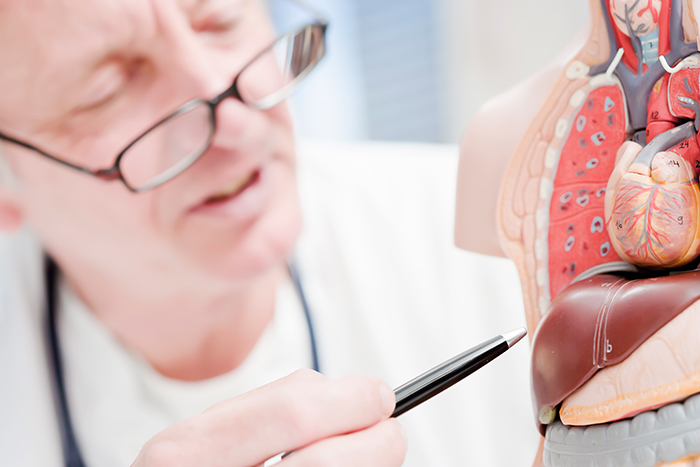Silent Liver Disease Poses Growing Health Threat

Obesity is known to cause heart disease, cancer and other chronic conditions. It is also tied to a current disease epidemic costing lives, health and $32 billion in US healthcare costs annually.
Nonalcoholic fatty liver disease, or NAFLD, currently affects 100 million Americans and millions of others worldwide. A new research study by the Intermountain Medical Center in Utah says that the disease will surpass hepatitis C as the top cause of liver transplants in America as early as 2020.
What’s happening in the liver?
The liver is considered one of our most important organs. It converts food into energy, maintains healthy sugar levels in our blood, protects our bodies from toxins and even helps blood to clot when needed. When the liver is diseased, it can begin a dangerous downward spiral that is sometimes irreversible.
Dr. Kalyan Ram Bhamidimarri is a liver disease expert at the University of Miami Health System and its Miami Transplant Institute. He explains that many factors are at play with nonalcoholic fatty liver disease.
“When someone drinks too much alcohol routinely, it could result in fatty liver and cirrhosis,” he says. “Excess weight and obesity can also result in fatty liver and can damage the organ. Nonalcoholic fatty liver disease typically occurs in non-alcoholics who are obese and in those with metabolic syndrome. These are individuals have several risk factors together, such as high blood pressure, unhealthy cholesterol levels, high blood sugar and too much fat in the abdominal (tummy) area.”
Types and stages of the disease
Fatty liver can present as isolated steatosis/ nonalcoholic fatty liver (NAFL)—fat in the liver but without inflammation or fibrosis. It can also present as nonalcoholic steatohepatitis (NASH), fat plus inflammation with or without fibrosis. NASH is much more dangerous.
“In cases of simple fatty liver disease, there’s no hepatitis (inflammation) to cause cellular liver damage,” says Dr. Bhamidimarri. “In cases of NASH, patients develop hepatitis, the cells in the liver get damaged and progressive scarring (fibrosis) can occur.”
The disease can progress over time. Fat and inflammation drive fibrosis (scar tissue). Liver fibrosis kills off liver cells and shrinks liver tissue. It leads to cirrhosis, or hard scarred tissue. After this, it may lead to irreversible end stage liver disease. The only medical option may be a liver transplant. This stage can also lead to liver cancer, one of the most deadly malignancies.
Growing impact on adults and children
According to the National Institutes of Health, between 25 to 40 percent of US adults have NAFLD. Most have simple fatty liver. But as many as 30 million American adults currently have nonalcoholic steatohepatitis (NASH), or 20 percent of people with NAFLD.
Non-alcoholic fatty liver disease in children is also a major health concern and its growing.
The NASH Education Program, initiated at the end of 2016, reports that childhood NASH cases began increasing 30 years ago. Why? In the United States, the percentage of obese children and adolescents has tripled since the 1970s.
“NASH is a silent disease,” adds Dr. Bhamidimarri. “It has no symptoms and it is challenging to diagnose. Advanced fibrosis and early cirrhosis are not easily seen. So any estimate is likely on the low side because obesity has become a public health problem.”
He says that the majority of deaths from NASH complications are caused by cardiovascular diseases (e.g. heart attacks and strokes); cancers of the GI tract, prostate, pancreas, breast and other organs; liver decompensation, and liver cancer.
Screening for non-alcoholic fatty liver disease
Experts like Dr. Bhamidimarri are reaching out to primary care providers to help share best practices for identifying at-risk patients. Other high-risk groups for NASH are:
- Hispanic adults
- Adults taking methotrexate for rheumatoid arthritis
- Cancer patients undergoing chemotherapy
- Individuals with rapid weight loss from crash diets
- People on total parenteral nutrition (TPN)
“We don’t have a simple blood test or scan, so NASH is a diagnosis of exclusion,” he explains. “A liver biopsy is the current standard to diagnose it accurately, but it is too invasive for general use. Just because someone is obese or has diabetes does not mean they have the disease. Even people who are extremely thin can develop NASH.”
Primary care providers can use a mathematical score non-invasively to predict those with greater risks, he says. One such method is the APRI score (short for aminotransferase/platelet ratio index). It helps doctors determine which patients are most likely to need a liver biopsy. After ordering less invasive lab tests, the doctor plugs the lab values into an online calculator to obtain a score.
“Low risk patients would be counseled about diet and exercise. High risk patients would be advised about the liver biopsy option and further steps in managing the disease,” says Dr. Bhamidimarri.
John Senall is a contributing writer for UMiami Health News. He is a former hospital and comprehensive cancer center communications director.
Tags: Diabetes, Dr. Kalyan Ram Bhamidimarri, fatty liver disease, NAFLD, NASH, non-alcoholic liver disease, Prediabetes, steatohepatitis
